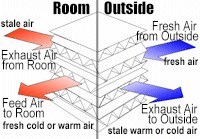|
Ventilation
Systems
Cost-efficient ventilation systems are vital in
modern buildings leading to occupants being more comfortable and
as a result more productive. This is particularly important when
you add the fact that we spend about 90% of our time indoors to
the raging debate currently surrounding indoor air quality - in
particular topics such as passive smoking, Legionnaires disease
and sick building syndrome.
But is it an economic argument too. In the workplace,
where salaries consume about 80% of the costs of office buildings,
the 3-10% loss in employee productivity believed to be caused
by poor air quality is quite significant. In fact, one study has
revealed that a drop in employee performance of just 2% is likely
to exceed the cost of providing good indoor air quality.
This low productivity is demonstrated by low employee
morale and high rates of sick leave as well as employee drowsiness;
headaches and nausea; poor concentration; dry itchy skin, irritated
eyes, noses and throats; excessive colds and allergies; and constant
grumbling about the humidity and/or temperature.
The effects of temperature have, in fact, been
quite well studied. Office temperatures above 24°C have been
found to result in a reduction in employee concentration of between
30 to 50%. In factories, where loss of concentration can be potentially
life threatening, accidents significantly increase at temperatures
greater than 25°C.
But temperature is just one component of IAQ, which
is also influenced by humidity pollutants and air movement. Some
of the reasons for poor IAQ therefore include inadequate HVAC
design or maintenance, insufficient amounts of fresh air and relative
humidities below 40%. As the pollutants include volatile organic
compounds, ventilating air should be pre-conditioned before it
is introduced to a building - exploding the old myth that the
answer to pollution is dilution' - which is part of the reason
that the HVAC system design is important.
|
One significant product currently on the
market that proves this point is the Mitsubishi
Lossnay unit that has sold over a million world-wide
in the last 20 years, largely due to the products' simplicity
and efficiency. Specifically Lossnay (which means 'no loss'
in Japanese) breaks the assumption in end-users minds that
effective ventilation systems have to be inextricably linked
to wasting energy and increasing costs. |


|
The units reduce overall energy costs by extracting
stale air and then recovering the heating or cooling energy to
either warm or cool in-coming fresh air This is achieved using
a cross flow total heat exchanger made of specially treated paper
plates and fins. Inside every Lossnay unit the fresh air and exhaust
air passages are completely separate, allowing the fresh air to
be preconditioned to the temperature and humidity levels of the
room air without mixing with the exhaust air.
The operating principle is based on the heat transfer
properties and moisture permeability of the treated paper. You
only have to roll a piece of ordinary paper into a tube, wrap
your hand around it and blow down the tube to see how effective
paper is at transferring both sensible and latent heat. This is
despite the fact that paper is generally regarded as heat insulating
material. In fact, in gas to gas exchanges, the thermal conductivity
of paper is comparable to copper and aluminium, which accounts
for the sensible heat exchange. The latent heat exchange occurs
as a result of osmosis, created by the paper's carefully controlled
porosity.
In fact the eight commercial units in Mitsubishi
Electric's Lossnay range, which can be installed independently
or used in conjunction with City Multi and Mr Sim products are
so efficient that they recover up to 70% of heat from stale air.
This reduces the energy costs of conventional air conditioning
equipment for a given fresh air delivery rate by up to 30% and
can also reduce the cost of the initial installation by between
5% and 10%.
Other Lossnay benefits include automatically humidifying
or dehumidifying in-coming air to match the room requirements
and the fact that only fans are used to simultaneously expel stale
air and introduce fresh air, enabling healthy ventilation, even
in an otherwise air-tight room. Additionally, as Lossnay is responsible
for a large reduction in the ventilation load it enables specifiers
to select cooling or heating plant with a 20-30% smaller capacity.
In contrast, past attempts to control air quality
and keep costs down led to complex solutions with laborious installation
work, resulting in systems that were hard to manage and control.
For example, on some air conditioning systems,
air renewal involves cyclic cooling and heating of the incoming
airflow, without enabling the heat and humidity of the air to
be used. Consequently, as the renewed air does not undergo heat
or humidity treatment the air conditioner has to work at full
power, potentially increasing the cost.
|
Enthalpy
The cost of maintaining constant thermal
conditions inside a room can be quite significant. As the
table shows, the enthalpic difference (or difference in
the amount of calories) between the air outside and inside
a room is about 3 kcal/kg in summer and 9 kcal/kg in winter.
To put these figures in a meaningful context, renewing the
air in a moderately filled restaurant containing approximately
40 people would require an additional 3,750 W in summer
and 11,300 W in winter This is in addition to the energy
needed to compensate for normal input and losses through
structures.
|
ENTHALPY
|
Interior
|
Exterior
|
Difference
|
|
Summer
|
12.8Kcal/Kg
|
15.8Kcal/Kg
|
3Kcal/Kg
|
|
Winter
|
9.4Kcal/Kg
|
0.4Kcal/Kg
|
9Kcal/Kg
|
|
Corby
Refrigeration, Gordon House, Dale Street, Corby, Northamptonshire,
NN17 2BQ UK
- Air Conditioning Services - Refrigeration
Systems- Ventilation Systems
- Humidification Systems -
|